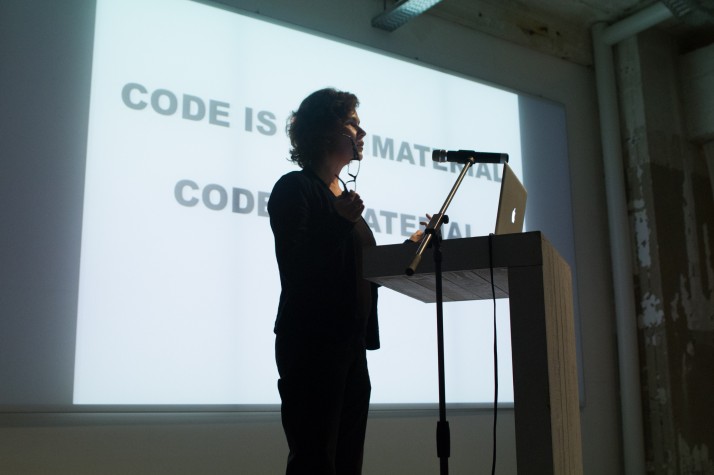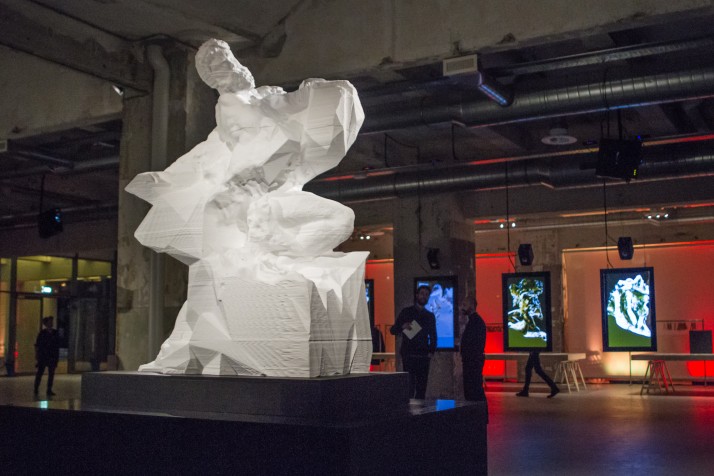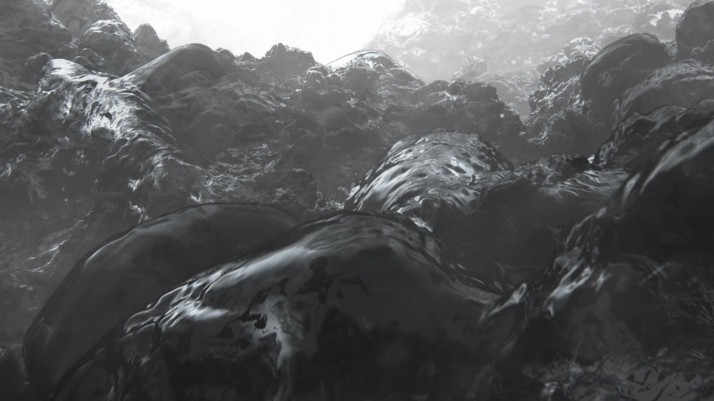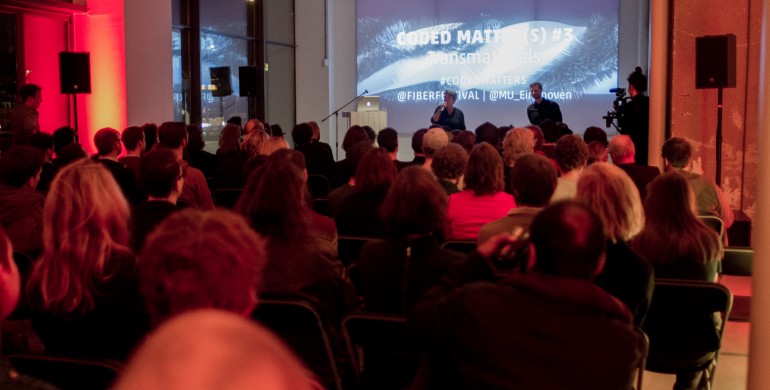Coded Matter(s) #3: Transmaterials – Recap
A new year, another successful edition of Coded Matter(s)! This edition, we asked blogger extraordinaire Nina van Doren (researcher and writer for LIMA) to write an informed report about Transmaterials for those of you who couldn’t make it to Eindhoven last Friday. If you’re more the visual type, there’s a bunch of photos on our Facebook (tagging! liking! oh, the good times you’ll have) and Flickr pages. Also, keep an eye out for our announcement of the exciting next edition next Monday…
But before you dive into the text below, a little heads-up for our readers in London: be sure to check out Alphaville, they have Quayola doing a headline presentation at their event today. Though it’s sold out, you can still get some evening-only tickets if you want to drop in for music and drinks.
And now, without further ado: a retrospective of Coded Matter(s) #3: Transmaterials:
After previous explorations of how code (re)programs the space around us, and how it enables musicians to create new sounds, FIBER kicked off the third edition of Coded Matter(s) in the fresh new year, continuing their mission of bringing together frontrunners within many different creative disciplines and addressing how technology facilitates new forms of artistic expression.
For this third edition FIBER collaborated with MU, moving from De Brakke Grond in Amsterdam to the Strijp-S exhibition space in Eindhoven to dive into the realm of materialism. Cutting to the core of the matter: if code is matter, what kind of matter is it?
As ‘trans’ in transmaterial might suggest, there is something different about these materials. Or is there? By tracing back the roots of thinking about the material world as established in the ancient philosophical theory of hylomorphism (Aristotle), Dr. Ann-Sophie Lehmann, an expert in the field of Material Culture Studies, explains in her lecture why we need to revise our understanding of materials in general and may need to adapt a new attitude towards material perception.

Everything you can see, touch, taste, or smell is made of matter. Matter makes up everything in our material world. We describe different kinds of matter by their material properties such as colour, weight, and structure. Sound, light, motion and electrical activity are, like code, often perceived as immaterial. But as we learned, this matter can be transcribed with computer applications. Allowing us to see what we could not before, providing us with matter we can interact with.
We can understand how people arrive at the idea of code being immaterial and why they find it so persuasive. The complexity of digital code is necessarily black-boxed in user-friendly interfaces, which makes it hard to banish assumptions of mysterious immateriality. Leaving us to think that code, as a series of written instructions that bring about a result, is not matter in itself.
Indeed, and especially within the domain of fine art, where throughout history the physical material of an artwork carries fundamental importance, code can be mystifying to art viewers. The good news is that when artists translate code back into three-dimensional objects we can begin to make sense of the matter. Digital fabrication methods like 3D printing and CNC milling enables these artists to design and fabricate objects that previously could only exist as digitally rendered concepts.

FIBER invited Quayola and Andreas Nicolas Fischer to talk about their work and projects that involve the use of automated planning systems that direct machines to produce physical objects or generate visual images. By explaining their work methods we are coming to terms with the deep suspicion toward the artist who is seen to be pulling one over on the audience by presenting work that ‘has been made by computers’. This is far from true. Rather than endangering the craft and skill of the artist, as has often been feared, a deeper understanding of digital matter and aesthetics can be obtained by engaging with computational processes.
Andreas Nicolas Fischer gave a broad overview of his work, making it quite clear that the possibilities of aesthetics that can be extracted from algorithms are innumerable. Whether drawn from complex repeating arrangements found in nature or abstract concepts that determine spatial order, the artist engages with them by finding new meaning.
Therefore, an artist who raises questions about the aesthetic condition of code has a much harder task, both in the sense of explaining why the inquiry is necessary, and in the sense of translating it into something that we are familiar with and can relate to.

When it comes to relating to things that we are familiar with, Quayola’s exhibition The Sculpture Factory, serves as a great example. With the use of software and digital fabrication methods Quayola reinterpreted Michelangelo’s art-historically drenched statue series Prigioni (1513-1534). He brilliantly reworked them, not pedantically but true to the spirit. The exhibition shows us not only how digital technologies can open up doors of perception when looking at a ‘fixed’ classical statue, but simultaneously how digital aesthetics can be translated into traditional iconography.
The secret to the artist’s craft lies in understanding, and working with the material, not by dominating it. This leads to an acute understanding of both the limits and potential of the material world. In this perspective we can see all materials as ‘transmaterial’.
It all comes down to the innately voracious human instinct of thinking in dualisms. We think of body and soul, the material and immaterial, art and technology, matter and form as binary oppositions. As it turns out, matter is not a ‘passive principle’ on which a shape can be imposed. It is rather an encounter between both form and matter, always interacting with one another.
Nina van Doren
